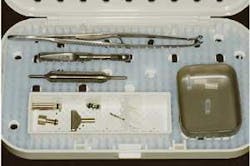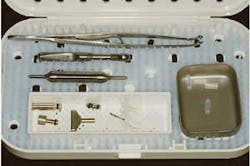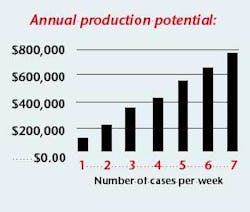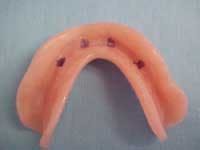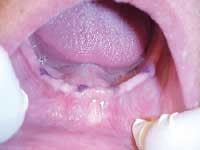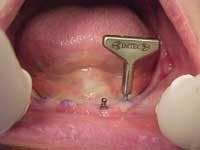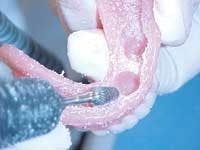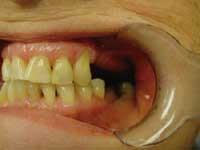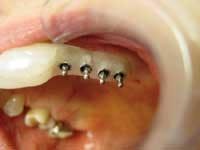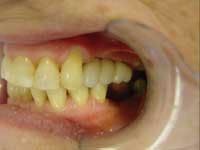Maximize your profits with minis!
Todd Shatkin, DDS
additional contributions from
Samuel Shatkin, DDS, MD
Benjamin Oppenheimer
Adam J. Oppenheimer
Four years ago, I thought I had a successful dental practice. My practice was generating excellent revenue, and I had a full schedule almost every day. If I wanted to increase my income, I added more patients to my daily schedule. So I worked harder, dealt with the hassles of insurance programs, and tried to see as many patients as I could in a single day. But that became exhausting, and I was looking for something more.
I had been placing dental implants for my entire career, about 10 years at the time. One morning, I came across an ad in one of the journals that perpetually flood my desk. The advertisement claimed, "Denture stabilization in less than an hour with mini dental implants!" The idea seemed impossible. It took me four to six months with numerous office visits to accomplish similar results. But my interest was piqued. I had to see for myself, so I called IMTEC Corporation and ordered the starter system for the MDI.
By the end of that year, my practice was transformed. I was scheduling fewer patients each day and making more money in the process! I was finally able to drop those troubling insurance plans, and I left my office feeling relaxed and satisfied. Most important, I was helping many patients who suffered from loose and uncomfortable dentures. I no longer had to "super-size" my schedule; on the contrary, I decided to "miniaturize." I was making money with minis.
The most surprising thing has been how simple mini implants are to use. Although I have quite a bit of experience performing oral surgery and dental implants, I've never had an advanced fellowship in implantology. I'm simply a general dentist with a desire to enhance my income and provide a great service to my patients. The MDI system has been the perfect match for me. After receiving my starter system, complete with a training video, a surgical kit, and a variety of implant types and sizes, I started placing the "minis" immediately. I began with a conservative approach, choosing only the quintessential cases for the procedure: full lower denture stabilizations. After gaining experience with a dozen or so cases, I began working on stabilizing full upper dentures, as well as making "palate-less" dentures.
Since the success rate of these small implants is so high, I also began using them for single and multiple teeth replacements with fixed prostheses. Now, after using this system for four years and placing hundreds of single- and multiple-tooth fixed cases, I've devised my own patent pending protocol for immediate single and multiple tooth replacement in one visit — the F.I.R.S.T.™ Procedure (Fabricated Implant Restoration and Surgical Technique). This simple procedure allows the dentist to place the MDI and the finished single crown or multiple crowns in one short visit (usually in about 30 minutes), further enhancing the diverse function of the MDI System. General dentists will find them easy to implement.
So what's the bottom line? By doing two of these denture stabilization procedures each week, you will increase your annual income by at least $250,000. Here's the math: The typical fee for each implant is $750, meaning a four-implant, lower denture stabilization will yield $3,000. Two cases each week adds up to $6,000 in income. If you work 45 weeks per year, your revenue will increase by a quarter-of-a-million dollars ($270,000 to be exact). Remember, these cases aren't invasive surgical procedures; you'll have the denture stabilized in an hour from start to finish. These figures do not even take into consideration if the patient needs new dentures, which is often the case and will further increase your revenue. Take it one step further and begin replacing individual and multiple missing teeth in one visit using the F.I.R.S.T. procedure. In four years, my practice income doubled, and yours can too.
This simple approach will show you how. First, you must select viable candidates. With experience, you can expand your selection pool to virtually any patient who walks in your door, but in the beginning, choose full lower-denture stabilization cases.
Second, make an anatomical diagnosis to determine the bone height, width, and density, and the localization of important anatomical landmarks (i.e. mental foramina). A panoramic radiographic assessment is sufficient in most cases.
A proper MDI size determination follows logically from the radiographic analysis. Implant lengths should approximate 75 percent of the mandibular height and 90 percent in the maxilla.
The transfer technique is a simple approach that I developed to transfer denture markings to the alveolar ridge. By marking the denture directly with a surgical marking pen and then placing the denture on a dry alveolar ridge, the future implant sites are easily localized (figures 1 & 2).
Use infiltration anesthesia on the buccal and lingual sides of the mark, as well as on the mark itself. This approach is preferable to a nerve block because it allows the patient continued sensation of the inferior alveolar nerve, decreasing the potential for nerve damage.
Site preparation involves the use of sterile surgical draping and preoperative oral rinsing (e.g. with chlorine dioxide). Drill a pilot hole with a vertical tapping motion and use copious irrigation. The patient's bone density determines depth: either two thirds or one half of the MDI height, for Type I and II bone, respectively, and 1/3rd for Type III bone. An endodontic rubber stopper can be used for proper measurement in this process (figure 3.)
The insertion of the implant is accomplished using the finger driver, winged-thumb wrench and/or ratchet wrench, depending on the resistance encountered. The implants should be turned slowly, until all threads are subgingival (figure 4.)
The prosthesis must then be prepared for seating. Housing abutments are snapped onto the implants and holes are placed in the denture with a laboratory bur, in the pre-marked locations. The holes are then filled with cold-cure acrylic, and are seated firmly onto the housings. After three to five minutes of drying, the prosthesis is removed with the housings firmly in place (figure 5.)
Total chair time? About an hour.
Postoperatively, the patient should wear his or her denture for the first 24 hours. This will preclude the peri-implant tissue from advancing up around the implants. The patients should be seen for follow-up after this 24-hour period, and then at three days and one week post-op. Maintenance visits should be scheduled every three months during the following year.
Using the F.I.R.S.T. protocol, a dentist can place MDIs and a finished custom laboratory crown or bridge restoration during the same visit. With the consultation services of a maxillofacial surgeon and an oral implantologist, we've taken the guesswork out of implant dentistry. The experts review the X-rays and models for each patient and construct an individualized surgical guide stent. In addition, the consultants select the appropriate type, size, and location of the implants for each patient case. The process is simple. Following radiographic analysis and assisting with case planning, the consulting dentists will perform surgery on the models. This is accomplished using the latest in dental laboratory technology and their vast experience in implant dentistry. F.I.R.S.T. Laboratories, LLC, then fabricates a surgical guide stent on these models using titanium cylindrical sleeves and clear acrylic (figure 6.)
They also design the custom crown restoration(s) or bridge(s) according to your prescription of the proper shade and type of restoration. These prostheses can be fabricated in PFM, all-porcelain, or fiber-core reinforced resin materials. All you have to do is snap on the stent (figure 7 & 8 ), place the predetermined implant(s) through the stent using the patent-pending protocol, and cement the finished prosthesis. Take an X-ray to confirm placement. No guess-work.
Imagine not grinding down abutment teeth for conventional bridge work. Consider only replacing the pontics. This is what I do now, and it has changed the way I practice dentistry. It is truly a wonderful way to perform dentistry.
The only remaining question is: Do these implants last? After placing more than 2,000 MDIs in the past four years — including those used for denture stabilization, single crowns, and multiple crowns and bridges, my overall success rate is around 95 percent. The results for fixed applications are even more impressive, with an efficacy of better than 97 percent. These great results, and the exhaustive research by Victor Sendax, DDS, and others have recently inspired the FDA to grant the MDI marketing clearance for long-term use in all clinical applications. The IMTEC Sendax MDI is the only small diameter (less than 2.3 mm diameter) implant to receive such status. In my opinion, mini dental implants will revolutionize implant dentistry. I predict that MDIs will become the treatment of choice for individual tooth replacement in the near future.
The benefits of minis are myriad: There is minimal discomfort during the procedure and very little post-operative discomfort (which is easily treated with over-the-counter analgesics); there are no incisions or sutures in most cases; the implants are loaded and restored immediately; the patient's cost is significantly lower (at least half) than the cost of conventional implants, which allows a single tooth to be replaced for less than a three-unit bridge; and, most notably, any general dentist can master the procedure with appropriate seminar or mini-residency training.
Along with Victor Sendax, DDS (the developer of the MDI), Charles English, DDS, and others, I provide seminar course instruction and mini residency programs across the United States and abroad to help dentists learn about the system and the various MDI techniques. Dentists can order the IMTEC Sendax MDI System and register for these training programs by calling (800) 879-9799. For information about F.I.R.S.T. Laboratories, LLC, contact Dr..Todd Shatkin at (716) 839-2959.
The Sendax MDI is a no-brainer for general dentists who want to enhance patient satisfaction, increase practice income, and simplify their daily routine. You, too, can make money with minis.
